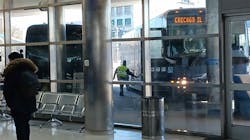Intercity bus stations shuttered even as coach travel rebounds, DePaul study shows
A “tectonic shift” is occurring in station arrangements for Greyhound and other intercity bus lines, according to a new DePaul University study. The shift stems from the ownership of many traditional bus stations being held by developers eager to convert them to non-transportation use amid a hot real estate market.
“The sudden closure of Greyhound bus stations around the country with traditional waiting areas is raising questions about how to meet better the needs of low-income travelers who lack the resources to travel by other modes,” noted Joe Schwieterman, DePaul professor and author of the recently released New Directions: 2023 Outlook for the Intercity Bus Industry.
In 2022, the push to redevelop station property has resulted in Greyhound relocating from its longstanding stations in Charlottesville, Va., Cincinnati, Ohio; Erie, Penn., Jackson, Miss., Knoxville, Tenn., Los Angeles, Calif., and North Little Rock, Ark. While some relocations, such as Los Angeles, brought these buses to a more centralized and desirable location at Los Angeles Union Station, others placed the new stops far from city centers. In Charlottesville, Jackson and Knoxville, the relocations sparked a public outcry due to the loss of comfortable indoor waiting rooms and the unappealing nature of the new locations. Recently, there have been reports that Greyhound stations in Cleveland, Ohio, Houston, Texas, Kansas City, Mo., Louisville, Ky., and Nashville, Tenn., are at risk.
“Creating solutions for the closure of stations can be found,” Schwieterman believes, but it will be several years “before the pain abates.”
The effort to find a new station or stop locations could put a new financial strain on bus lines, which are simultaneously dealing with driver and equipment shortages. Some are also amid adjustments due to the accelerating pace of integration by FlixBus and Greyhound, the country’s two most extensive scheduled-long distance services.
“Evidence that privately run bus stations’ boom years were long past has long been clear,” Schwieterman noted, pointing out some became vastly oversized as routes were cut.
“In many cities, bus lines moved to intermodal transportation centers, Amtrak stations, convenience stores, transit hubs, curbside spots or, in rare instances, airports,” he said.
However, the loss of indoor waiting room amenities has, in many cities, been challenging for those on multi-leg trips requiring transfers during nighttime hours, those with lengthy layovers or during a time of inclement weather.
“When indoor waiting facilities become unavailable, bus lines are sometimes forced to discontinue selling tickets that require transfers at those points. This chips away at the quality of the national bus network,” said Allison Woodward, a co-author of the study.
Part of the problem stems from the changing ownership of many bus stations. Most privately run Greyhound stations were retained by FirstGroup, Greyhound’s previous owner, after that bus company was sold to FlixMobility in late 2019. Last year, FirstGroup acted on its desire to divest itself of its North American assets by selling many stations to other parties. This sale has caused the timetable for the redevelopment of the properties for other uses to accelerate significantly.
The problem is magnified by what some regard as ambiguities in federal regulation requiring intercity bus lines to be provided “reasonable access” to public transit facilities. These transit hubs are often well-maintained and centrally located, and they have security protocols to keep passengers safe. However, bringing intercity bus lines to these hubs generates costs, and the regulation does not stipulate the fees the government can charge for their use. The rents some local governments demand from privately run bus lines to move into and use these hubs are often prohibitive. Some officials justify their demands out of a desire to refrain from subsidizing a private business, according to the study.
“What constitutes as ‘reasonable access’ is complicated,” Schwieterman explained before adding “the best solution may be new legislation that brings greater clarity to this question.”
In other areas, such as in Europe, public agencies usually take responsibility for providing affordable options for private bus lines, which are seen as critical public services. Schwieterman notes cities including Boston, Mass., Denver, Colo., Milwaukee, Wis., Raleigh, N.C., and Washington, D.C., have created modern terminal facilities widely available to intercity bus lines. In Atlanta, a new station is being built with state of Georgia funds that will have similar benefits, but the outlook is more troubling in other cities.
“At a minimum, bus lines need to educate travelers about the absence of amenities, particularly indoor waiting areas on trips that involve transfers,” Woodward noted. “They will need to be transparent about potential hardships when displaying search results."
The study concludes the pressure to resolve these problems will escalate as more passengers return to intercity bus travel. The DePaul study predicts ridership will rise to 80-85 percent of pre-pandemic levels later this year if the driver shortage continues, up from the present level of about 70 percent.
DePaul University’s Chaddick Institute is having a free webinar on its new study (complimentary download here) on Feb. 23, 2023, from 2 p.m. – 2:50 p.m. CT. To register, click here, or to join its Intercity Bus Listserv or reach the study team, contact [email protected].



